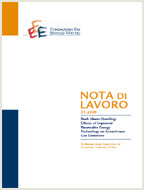An Integrated Assessment of Super & Smart Grids

03.10.2013
Elena Claire Ricci
C61, Q42, Q54
Smart-Grids, Climate Policy, Integrated Assessment, Renewable Energy, Residential Power Generation, Demand Side Management Concentrated Solar Power, Super-Grids, Electricity Trade
Climate Change and Sustainable Development
Carlo Carraro
We assess the optimality of investments in power grid innovation, under both technological options of Super and Smart Grids, using the WITCH model in the version that includes Super-Grids. Super Grids allow producing and trading of electricity generated by large scale concentrated solar power (CSP) plants in highly productive areas that are connected to the %demand centres through High Voltage Direct Current (HVDC) cables. We extend the model to include also Smart-Grids that allow: i) to increase the share of renewable power manageable by the power network, ii) to reduce the costs of customer relationships via Smart Meters; iii) residential consumer to generate electricity via micro-photovoltaic plants, and iv) residential consumer to generate virtual electricity via consumption management. We find that it becomes optimal to invest in grid innovation, in order to start gaining the management benefits and taking advantage of consumer generating opportunities (of electricity and “nega-watts”), starting in 2010 and to exploit the increased possible penetration of renewable energy sources from 2035. Long-distance CSP generation becomes optimal only from 2040, and trade from 2050; but it reaches very high shares in the second half of the century, especially when penetration limits are imposed on nuclear power and on carbon capture and storage operations (CCS). On the whole, climate policy costs can be reduced by large percentages, up to 48%, 34%, 24% for the USA, Western Europe, Eastern Europe, respectively, with respect to corresponding scenarios without the grid innovation via Super and Smart Grid option and with limits on nuclear power, CCS, and CSP import. The analysis is then extended to compare these options considering, at least qualitatively, the differentiated impacts on the environment, technology, organization, society, local and national economies and geopolitics.
+++
Suggested citation: Ricci, E.C., (2013), ‘An Integrated Assessment of Super & Smart Grids’, Nota di Lavoro 84.2013, Milan, Italy: Fondazione Eni Enrico Mattei.
